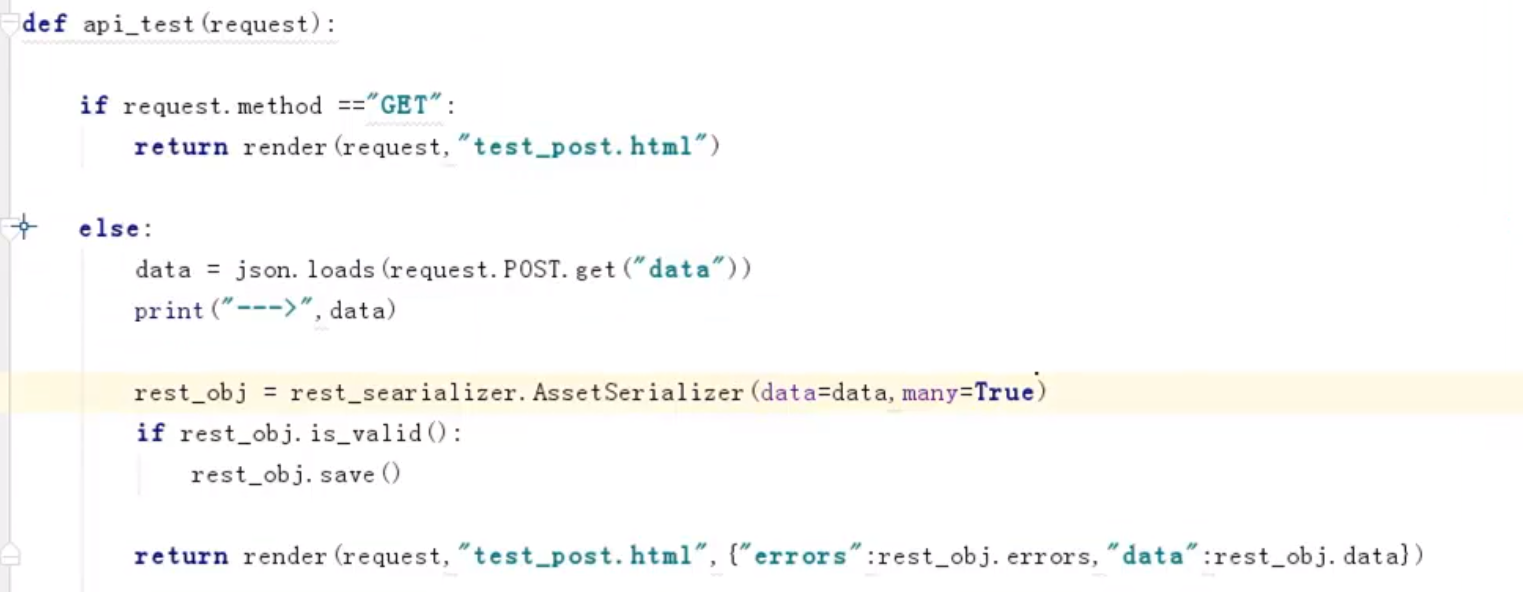DRF-Django rest framework
环境:
事先安装python、虚拟环境、django,项目的创建省略。
国内清华大学镜像
pip install python==3.10.5 -i https://pypi.tuna.tsinghua.edu.cn/simple/
pip install virtualenv -i https://pypi.tuna.tsinghua.edu.cn/simple/
pip install virtualenvwrapper -i https://pypi.tuna.tsinghua.edu.cn/simple/
pip install django==4.1.4 -i https://pypi.tuna.tsinghua.edu.cn/simple/
网址:
https://www.django-rest-framework.org/
安装:
pip安装
pip install djangorestframework #DRF pip install markdown # Markdown support for the browsable API. pip install django-filter # Filtering support
github安装
git clone https://github.com/encode/django-rest-framework
国内豆瓣镜像安装
pip install djangorestframework https://pypi.douban.com/simple
注册:
django 项目的 settings.py 文件中进行配置
INSTALLED_APPS = [ ... 'rest_framework', ]
权限:
django 项目的 settings.py 文件中进行配置
REST_FRAMEWORK = {
# Use Django's standard `django.contrib.auth` permissions,
# or allow read-only access for unauthenticated users.
'DEFAULT_PERMISSION_CLASSES': [
'rest_framework.permissions.DjangoModelPermissionsOrAnonReadOnly' # 默认域内全部可以访问,但只能只读
]
}
总路由:
django 项目的 urls.py设置
urlpatterns = [
...
path('admin/', admin.site.urls),
path('别名(例如:app1)/', include('app名称.app路由文件名(例如:app1.urls)'))
]
序列化:
创建ModelSerializer
django 项目中创建serializers.py文件,名称可以自定义。
from django.contrib.auth.models import User # 此处可以换成自己项目的自定义用户表 from 自己的项目 import models
from rest_framework import serializers
# Serializers define the API representation.
# 定义表现形式
# HyperlinkedModelSerializer 类与 ModelSerializer 类相似,只不过它使用超链接来表示关系而不是主键。HyperlinkedModelSerializer 会自动生成一个 url 字段来表示超链接 class UserSerializer(serializers.HyperlinkedModelSerializer): class Meta: model = User # 此处可以换成自己项目的自定义用户表 fields = ['url', 'username', 'email', 'is_staff']
深度depth,设置关联的层级,防止层级太多导致的资源占用过多。
class UserSerializer(serializers.HyperlinkedModelSerializer): class Meta: model = User # 此处可以换成自己项目的自定义用户表 fields = ['url', 'username', 'email', 'is_staff']
depth=2 # 外键存在多级时,仅关联两级
# 设置在class Meta:下
# 我们可以在 extra_kwargs 设置中的 view_name 和 lookup_field
# 来正确配置我们的 URL
# view_name 和 urls.py 中的 name 参数相对应,表示使用哪个 url
# lookup_field 表示用哪个字段来作为 url 的唯一识别标记
# 本例中每个 Profile 的 url 是通过 id 来区分的,所以该字段用 id
extra_kwargs = { 'url': {'view_name': 'profile-detail', 'lookup_field': 'id'}, 'owner': {'lookup_field': 'id'} }
视图:
创建视图集合ModelViewSet,并在视图中绑定序列化
# ViewSets define the view behavior.
from django.contrib.auth.models import User # 此处可以换成自己项目的自定义用户表 from 自己的项目 import models
from rest_framework import viewsets
from 项目名称 import 序列化文件名(例如:serializers)
class UserViewSet(viewsets.ModelViewSet): queryset = User.objects.all() serializer_class = UserSerializer
自定义视图方法

路由:
创建app的路由文件urls.py
router的设置
# Routers provide an easy way of automatically determining the URL conf.
from django.urls import path, include # 引用path, include
from rest_framework import routers
from 项目名称 import 视图文件(例如:views) 或者 from 项目名称.views import 视图集合中某个ModelViewSet(例如:UserViewSet)
router = routers.DefaultRouter() # 生成router实例
router.register(r'users', UserViewSet) # 注册router实例的视图映射
# Wire up our API using automatic URL routing. # Additionally, we include login URLs for the browsable API. urlpatterns = [ path('', include(router.urls)),
path('api-auth/', include('rest_framework.urls', namespace='rest_framework')) # 用于api接口登录验证
]






【推荐】国内首个AI IDE,深度理解中文开发场景,立即下载体验Trae
【推荐】编程新体验,更懂你的AI,立即体验豆包MarsCode编程助手
【推荐】抖音旗下AI助手豆包,你的智能百科全书,全免费不限次数
【推荐】轻量又高性能的 SSH 工具 IShell:AI 加持,快人一步
· 25岁的心里话
· 闲置电脑爆改个人服务器(超详细) #公网映射 #Vmware虚拟网络编辑器
· 基于 Docker 搭建 FRP 内网穿透开源项目(很简单哒)
· 零经验选手,Compose 一天开发一款小游戏!
· 一起来玩mcp_server_sqlite,让AI帮你做增删改查!!